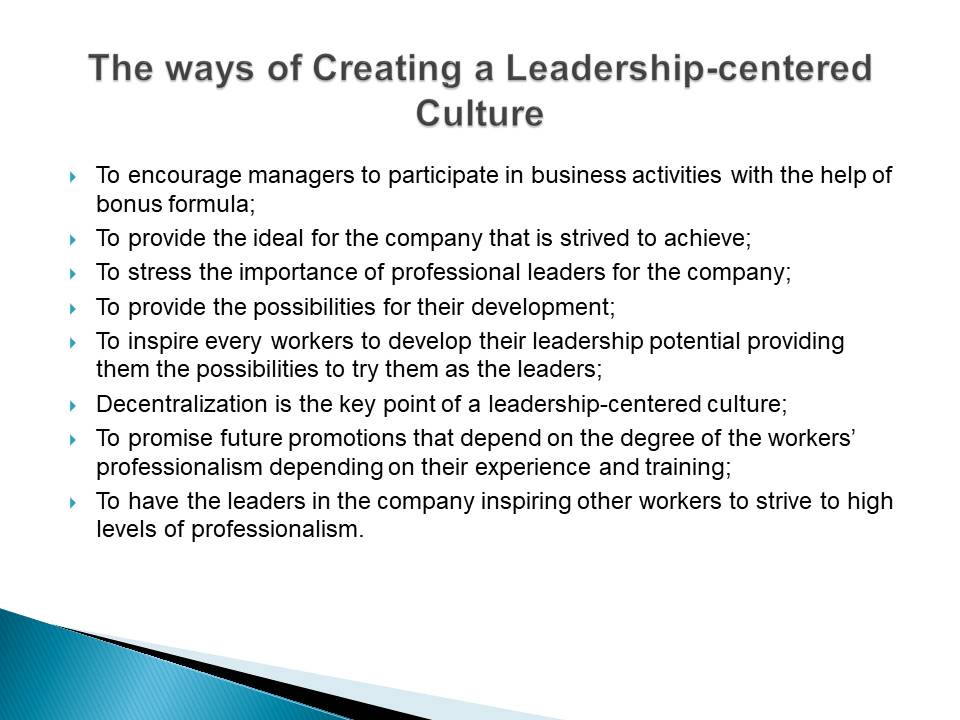- The Qualities of a Good Leader-Manager
- The Difference Between Management and Leadership
- Setting a Direction as a Foundation of Change
- Aligning People vs. Organizing and Staffing
- Motivating People vs. Controlling and Problem Solving
- The Main Techniques of Motivation
- How to Create a Good Leader-Manager?
- The ways of Creating a Leadership-centered Culture
The Qualities of a Good Leader-Manager
Leadership Qualities:
- Trustworthy;
- Self –confident and awareness of the impact over other people;
- Permanent desire to learn, develop and perfect;
- High self-worth and self-esteem;
- Openness and communication skills;
- Creativity and dedication to the work;
- Magnanimity and fairness.
Qualities of an Excellent Manager:
- Self-discipline and purposefulness;
- Professional knowledge and intuition;
- Creativity and versatility;
- Decision-making and organization skills;
- Conceptual and time-management skills;
- Interpersonal skills and empathy;
- Persuasion and communication skills.
There are a lot of qualities of a good leader and a good manager. The leadership qualities are trustworthy, self-confident, impact over other people, permanent desire to learn, develop and perfect, high self-worth and self-esteem and others while a good manager should have a self-discipline, purposefulness, professional knowledge, creativity, versatility, decision-making, organization skills and others. Factually, a good leader as well as a good manager should have the similar qualities as far as a good leader-manager is in demand in many modern companies.
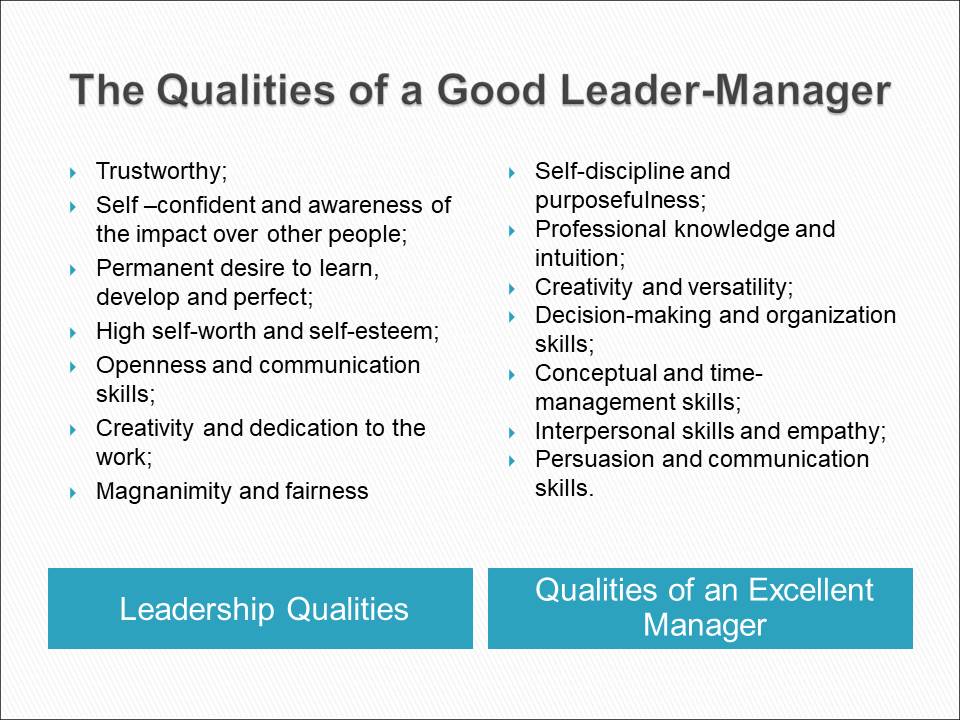
The Difference Between Management and Leadership
Leadership:
- Coping with change;
- The main aim to survive and compete effectively in a new environment;
- The main strategy is setting a direction for the future development;
- Aligning people is the main method of achieving the plan;
- Motivating and inspiring are necessary for achieving effective results.
Management:
- Coping with complexity;
- The main aim is to control the practices and procedures effectively for the development of the company;
- The main strategies are planning and budgeting;
- Organizing and staffing are used to develop the capacity to achieve the results;
- Controlling and problem solving are used to ensure plan accomplishment.
Nevertheless, the notions of management and leadership are different. Leadership deals with change while management deals with complexity. A good leader should follow the changes at the company and find the reasonable decisions while a good manager should predict these changes dealing with the global structure and goals of the company. The main aim of leadership is to survive and compete effectively in a new environment while the main aim of management is to control the practices and procedures that are effective for the development of the company. A good leader aims at the setting a direction for the future development of the company while a good manager should plan and budget its future development. Leaders should align, motivate and inspire workers to achieve better results while managers should organize and control the work of the employees to ensure plan accomplishment.
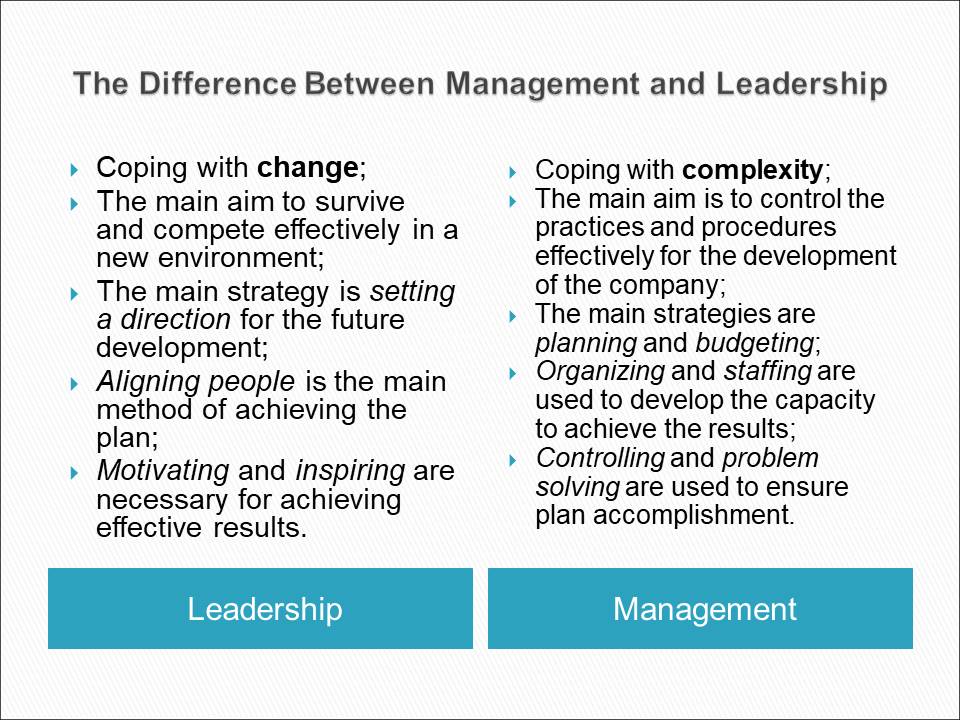
Setting a Direction as a Foundation of Change
- Setting a direction is considered to be an inductive process.
- Setting a direction is creating vision and strategies not producing plans.
- Strategies are based on analyzing and gathering information.
- A realistic competitive strategy is the crucial point of the vision.
- Strategies and vision are fundamental for making plans.
It is necessary first to set a direction and then to develop a plan as far as the kind of direction clarifies the kind of planning that is relevant to this direction.
A good leader first of all set a direction for the development of the company while a good manager reacts to the changes at the world market in the appropriate way. Setting a direction is considered to be an inductive process comparing to foundation of change. Managers produce good plans when leaders set a direction creating vision and strategies. Strategies are based on analyzing and gathering information that is a crucial point for the company. Strategies and vision are fundamental for making plans. Factually the role of the leader and manager are interdependent. It is necessary first to set a direction that is the primary function of a good leader and then develop a plan that is the duty of the manager as far as the kind of direction clarifies the kind of planning that is relevant to this direction.
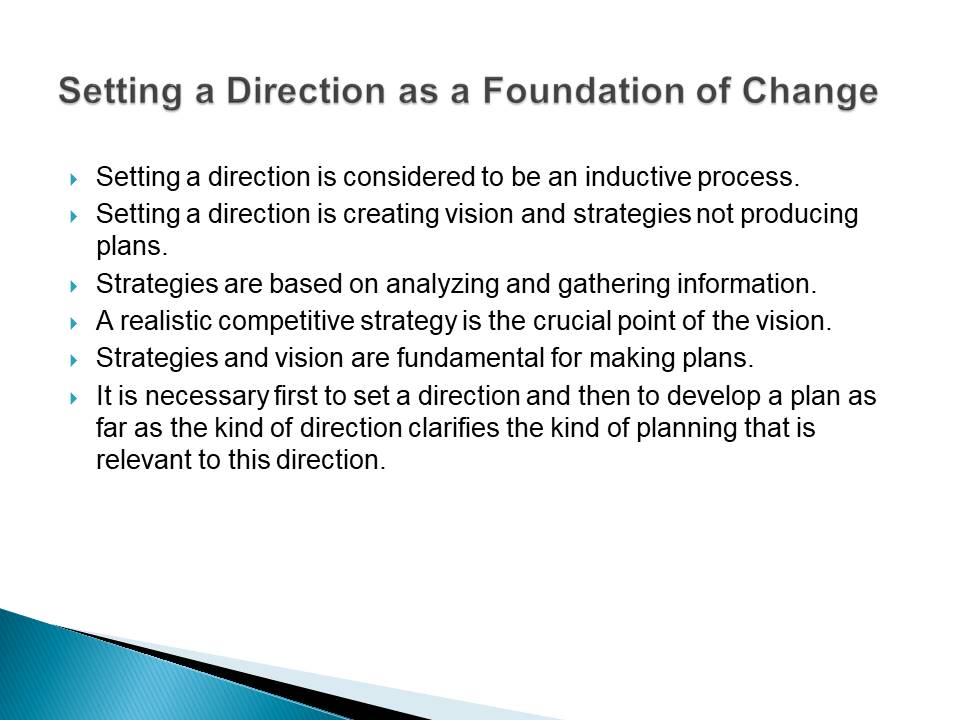
Aligning People vs. Organizing and Staffing
The ability of aligning people as a peculiar feature of a good leader:
- Leaders motivate people by satisfying their basic human needs.
- Leaders communicate with the staff in order to make them understand a new direction and follow it.
- Aligning people is considered to be connected to the communication challenges not to the design problems.
- Credibility is a crucial point in aligning people. Leaders should make people believe the message.
The skills of organizing and staffing as the main requirements for a good manager:
- Managers control people by pushing them in the right direction.
- Managers organize human resources in such a way that the plans are achieved in the most effective way.
- Organizing and Staffing are considered to be rather architectural and hierarchical decisions.
- Power is a crucial point in organizing and staffing. Managers should control the people’s actions and make them work in such a way the company needs.
The ability of aligning people is a peculiar feature of a good leader while a manager should have the skills of organizing and staffing. Leaders motivate people by satisfying their basic human needs when managers control people by pushing them in the right direction. Leaders use their communication skills to make the workers understand a new direction of the development of the company and follow it. Managers use their organization skills to structure the work of the company in such a way that the plans are achieved in the most effective way. Organizing and staffing refers rather to architectural and hierarchical decisions while aligning people is considered to be the design problems. Credibility plays an important role in the process of aligning people as far as leaders should make people believe the message. Managers should have power over the workers in order to control their actions and make them work in such a way the company needs.
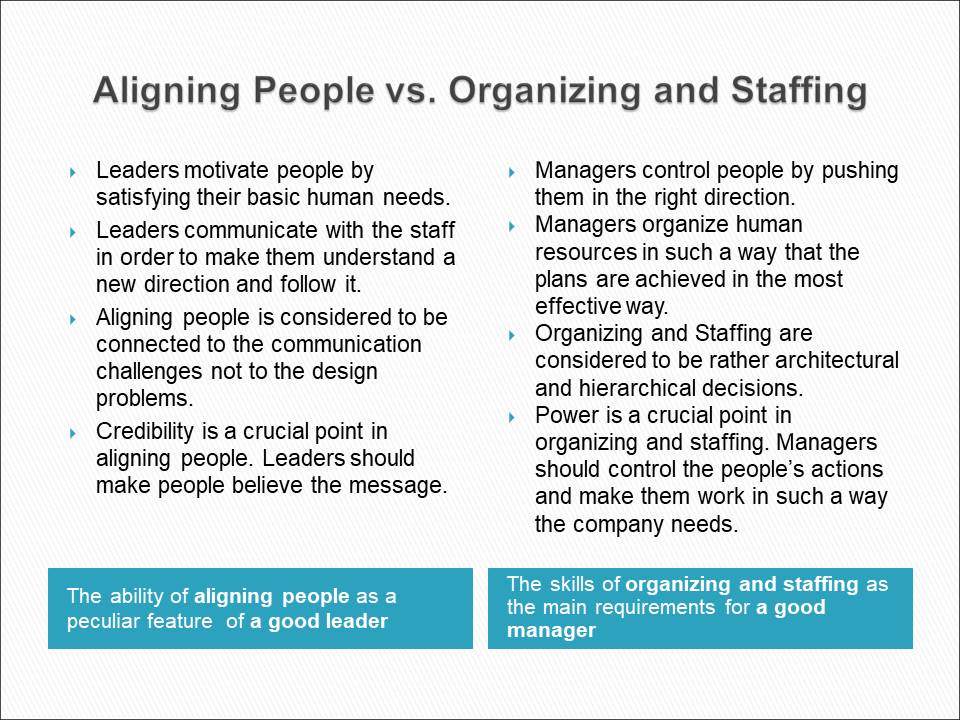
Motivating People vs. Controlling and Problem Solving
- Motivation inspires people to achieve results despite the obstacles on their way.
- Good leaders stimulate the workers to achieve particular goals doing all their best.
- Leaders inspires the workers to follow the right direction.
The ability to motivate other people is the peculiar feature of a good leader.
- Controlling the workers’ actions and solving the problems hampering the realization of the plan allow the manager to direct the company at the right direction.
- Good managers build organization that achieves the particular targets.
- Managers push the workers in the right direction.
The skills of controlling and problem solving are necessary for a successful manager.
Leaders should be very skillful at motivating people while managers should have skills of controlling and problem solving. Managers control the workers’ actions and solve the problems hampering the development of the company. Leaders motivate workers to achieve the goals despite the obstacles on their way. The workers are inspired by the leaders to do all their best to achieve the result while managers build organization that achieves the particular targets. Leaders inspire the workers to follow the right direction while managers push them to do it.
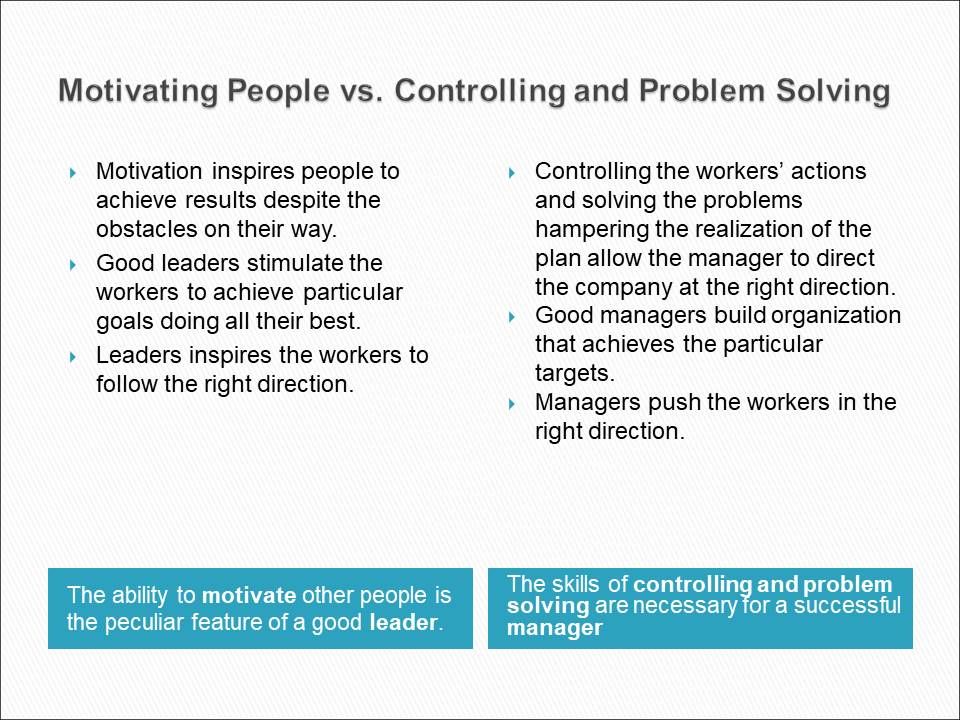
The Main Techniques of Motivation
- To satisfy basic human needs of the workers in order they achieve better results;
- To provide a sense of involvement in the development of the company and the feeling of importance for the working process speaking about the role of every worker and their important functions;
- To express recognition and enhance workers’ self-esteem providing feedback, coaching and role modeling and helping them to grow professionally and realize all their capabilities;
- To give people a sense of control involving them in the making-decision process to achieve the organization’s vision;
- To provide the ideal and inspire workers follow it.
Motivation is very important to be a successful leader. There are a number of techniques used by leaders to motivate people. It is necessary to satisfy basic human needs of the workers in order they achieve better results. Leaders should provide a sense of involvement in the development of the company and the feeling of importance for the working process speaking about the role of every worker and their important function. Every worker should feel that he/she is valued by the leader. It is very important to express recognition and enhance workers’ self-esteem providing feedback, coaching and role modeling and helping them to grow professionally and realize all their capabilities. Leaders should give people a sense of control involving them in the making-decision process to achieve the organization’s vision. Leaders should be an example for their workers and inspire them to follow their example.
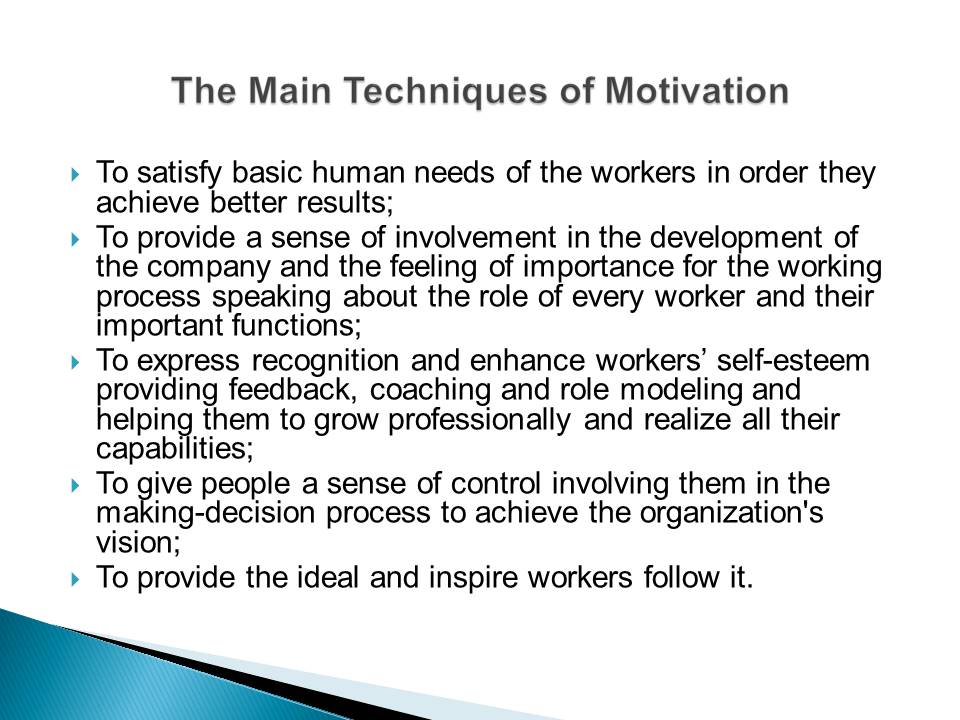
How to Create a Good Leader-Manager?
- To recruit people with leadership potential;
- To manage the careers’ patterns;
- To make significant changes early in the career;
- To learn both from triumphs and failures;
- To have a chance to use all leadership and management potential on practice;
- To provide special task-force assignment or the training courses for the development of professional skills;
- To create challenging opportunities for young employees;
- To create more challenging jobs at the company pushing responsibility lower in an organization. This process is known as decentralization and is very successful at developing new leader-managers.
Many companies lack good leader-managers. It is quite difficult to find a professional leader-managers in our times but the companies may train and develop their employees to become good leader-managers. They may recruit people with leadership potential providing them possibilities to study, practice, develop and perfect their skills. There should be careers’ patterns at the company. More than that, changes should be made early in the career. Every worker should not give up. Failures and wins are necessary for the development. Companies should provide a chance for their workers to use their potential and provide them special task-force assignments or the training courses for the development of their professional skills. It is necessary to create more challenging jobs at the company pushing responsibilities lower in an organization. The process that is known as decentralization is very effective at developing new leader-managers.
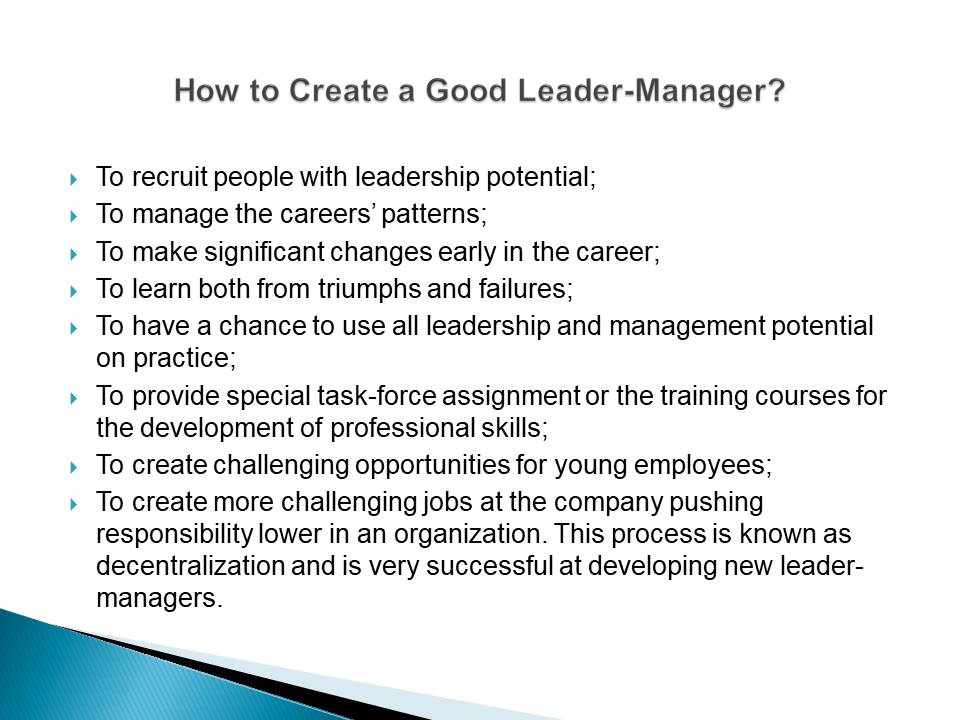
The ways of Creating a Leadership-centered Culture
- To encourage managers to participate in business activities with the help of bonus formula;
- To provide the ideal for the company that is strived to achieve;
- To stress the importance of professional leaders for the company;
- To provide the possibilities for their development;
- To inspire every workers to develop their leadership potential providing them the possibilities to try them as the leaders;
- Decentralization is the key point of a leadership-centered culture;
- To promise future promotions that depend on the degree of the workers’ professionalism depending on their experience and training;
- To have the leaders in the company inspiring other workers to strive to high levels of professionalism.
Many popular companies have achieved a success developing a leadership-centered culture. There are a lot of ways to make successful leader-managers from the ordinary employees. Any leader may be a successful manager while any manager may be a good leader. It is necessary to encourage managers to participate in business activities with the help of bonus formula. There should be the ideal at the company that is strived to achieve by everyone. The importance of the leaders for the company should be stressed. A wide range of possibilities should be provided at the company. Motivation and inspiration are very valuable for the development of new leader-managers. Every worker should be sure of their future promotion if they develop their professional skills with the help of training. Decentralization is considered to be the key point of a leadership-centered culture. Leaders are necessary at the company to inspire other workers to develop their skills and demonstrate better results. There is always a lot of goals that should be desired to achieve. Development is an endless process and everyone should not stop training their skills and broadening their potential.
